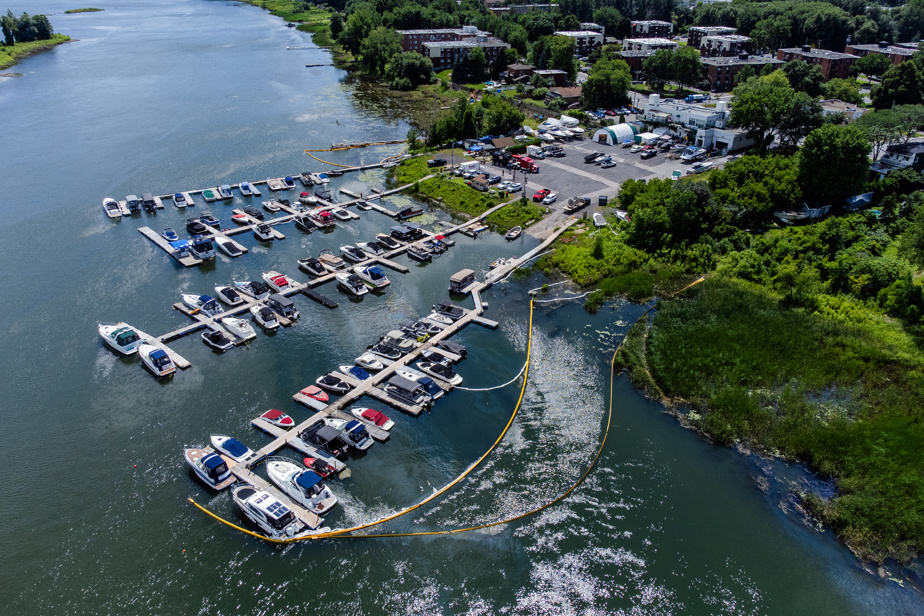Authorities have finally identified the source of the mysterious oil slicks observed in Pointe-aux-Trembles shortly after a new episode of pollution soiled the freshly cleaned banks of the river.
What there is to know
A new layer of pollution appeared around the Pointe-aux-Trembles marina on Thursday, two weeks after a similar episode occurred in the same location.
The authorities quickly identified the origin of this new spill, unlike the previous one, the source of which had remained unknown until now.
The Rivers Foundation is urging Quebec to explain the investigative steps taken following the first spill, which proved to be in vain.
A new black, slimy puddle has appeared around the Pointe-aux-Trembles marina, a few days after the end of the cleanup operation following a similar spill that occurred in the same area earlier this month.
The Canadian Coast Guard, responsible for the first collection operation, quickly confirmed around noon that it had “remobilized personnel to the scene.”
“Booms are deployed, a suction truck to recover the contaminated water is on site and absorbents are also placed in the water,” the federal agency said.
She added a few hours later that the source of the spill had been identified. It is a “storm drain that flows into the St. Lawrence River,” the Coast Guard said on X, explaining that it was transferring command of the investigation to Quebec, which has jurisdiction over the mainland.
-

PHOTO CHARLES WILLIAM PELLETIER, SPECIAL COLLABORATION
-

PHOTO CHARLES WILLIAM PELLETIER, SPECIAL COLLABORATION
-

PHOTO CHARLES WILLIAM PELLETIER, SPECIAL COLLABORATION
-

PHOTO CHARLES WILLIAM PELLETIER, SPECIAL COLLABORATION
1/4
In a pipe
Unlike the first spill, the origin of which could not be identified, the Quebec Ministry of the Environment had indicated earlier that a “land source would be possible.”
“Hydrocarbons were found in a pipe running along the Tricentenaire Boulevard and having the marina as its outlet,” said its regional spokesperson, Ghizlane Behdaoui. “The steps are continuing in order to trace the origin of the contamination.”
Samples of this oil slick will however have to be analyzed to verify whether it is the same pollution as that observed at the Pointe-aux-Trembles marina last Thursday and July 11.
According to our information, employees of the Ministry of the Environment and the City of Montreal visited several industries in the sector as part of this investigation.
Affected birds
Employees from Urgence Marine Environnement (UME) called in as reinforcements were busy cleaning the marina within the perimeter of the new cleaning operation, it was observed The Press.
On the docks and by boat, they filled large bags with a black slimy material polluting the water. “There will be a lot [de sacs] ” said UME employee Francis Kubi. According to him, this new leak would however be less significant than the previous one.
Coast Guard agents flew a drone to measure the extent of the leak. According to them, two leaks rarely occur in the same place. “To my knowledge, this is the first time, it’s not common, it’s still a pretty interesting case for us,” said Jean Bourdon, superintendent of the Coast Guard’s marine hazards environmental response program, Central Region.
Wildlife enforcement officers were dispatched to the marina as animals were affected by the spill. Birds were found covered in black oil. Near the shore, a seagull with a broken wing was struggling to clean its feathers.
“It smells even stronger than last time,” said François Cantin, a resident living along the river in the area.
The general director of the Jacques-Cartier ZIP Committee, Élise Mercure, indicated that she had reported the presence of contaminants on the banks of Sainte-Thérèse Island, much further east than the Pointe-aux-Trembles marina, a sign that this new spill covered a large area.
Barely finished
To add insult to injury, it occurred just as the Coast Guard had indicated three days earlier that it had completed cleaning up the banks of the St. Lawrence River after a first oil spill at the same location on July 11.
In total, 19,000 liters of a mixture of water and hydrocarbons, which contained approximately 1,000 liters of hydrocarbons, were pumped out. But the source of the black, viscous material, later identified as engine oil, remained unknown to this day.
A few days earlier, Quebec had suspended its investigation into a possible land-based source of the contamination, a decision that was “unacceptable” in the eyes of the Rivières Foundation.

PHOTO CHARLES WILLIAM PELLETIER, SPECIAL COLLABORATION
“We are asking that the minister report on the work that was actually done the first time and that they learn lessons from it, that it be known and that measures be taken to ensure that it does not happen again,” hammered home its president, Alain Saladzius, on Thursday.
When questioned on this subject, the Ministry of the Environment limited itself to explaining that “previous research during the first spill had not detected any hydrocarbons in the pipes”.
Alain Saladzius believes it is only a matter of time before government inspectors catch the polluter. “They just have to go up the pipes to get to the point of discharge,” explains the water treatment engineer.
